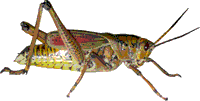Entomology Collections, General

Entomology Papers from Other Sources
Document Type
Article
Date of this Version
1991
Abstract
In 1987 and 1988, samples of preserved insects were extracted from the ice of Knife Point Glacier, Fremont County, Wyoming. The glacier lies at an altitude of 3500 m a.s.l. in the Shoshone National Forest, Wind River Range, and is known to contain preserved insects. Although the glacier has undergone extensive recession in the last 50 yr, some insect deposits are still embedded at 20 to 25 cm below the surface and perhaps much deeper. The frozen deposits appear to consist entirely of grasshoppers. A few, virtually intact, specimens and body parts were in a state of preservation that allowed their identification as Spharagemon campestris McNeill and Melanoplus spretus (Walsh) or M. sanguinipes (F.). The majority of the deposits consisted of partial bodies and isolated parts, including, in order of frequency: mandibles, tibiae, tentoria, femora, wings (primarily tegmina), and cingulae/epiphalli. Deposits from various depths and locations on the glacier were radiocarbon dated at 205 + 65 to 450 + 80 yr BP. Although access to the glacier is quite difficult, the insects are better preserved than any glacial deposit documented in recent history. Thus, the state of preservation and age of the frozen deposits would suggest that additional, intensive sampling may be valuable in obtain- ing information on the ecology of grasshoppers prior to European settlement of North America.


Comments
Published in Arctic and Alpine Research, Vol. 23, No. 1, 1991, pp. 108-114.